25. July 2013 |
Maitane Iturrate Garcia |
Comments Off on First part of my field work: done!
by Maitane Iturrate
July 25, 2013
It is late July and outside is windy, rainy and very cold with temperatures of 5 degrees Celsius, but at least no mosquitos. We have reached the point where it is very difficult to know the date or how many days are left before returning home. Every day the same pattern: sleep, get up, have breakfast, work, have lunch, work, have dinner, carry wood, chop wood, sleep…
Today I am starting the second part of my field work. After two intense weeks of hard work with Olga, assessing the biodiversity of the area and the local flora, she left this morning. I am really grateful to her. I have learnt a lot about doing plant community descriptions, relevés, species names and features, how to do a herbarium, and many other things. I had sometimes difficulties in keeping up with her (she is full of energy), but we ended up with 120 species (or maybe more, we must wait for the specialists results for some of them). In addition, I have my first set of results for my plots species composition! It is great being able to see these results after so many hours of work, sweat, tears and nights without sleeping preparing the field plan for this year.
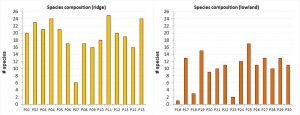
Species composition of the ridge and lowland plots in total number of species (Figure: M. Iturrate, 2013)
The second part of my fieldwork focuses on plant traits and abiotic variables at plot and individual scales, including plant architecture. There is still a lot of work outstanding and only “few” days left, but I am sure I will manage, especially considering that days are very, very long (still 24 hours of daylight). After six plots, the point quadrat method per species has no secrets for me :-). And the soil part is quite entertaining, a bit dirty, but lot of fun.
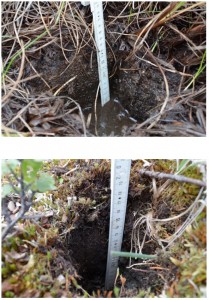
Soil sampling at the selected plots (Photos: M. Iturrate, 2013)
Abgelegt unter: Up and running
23. July 2013 |
Gabriela Schaepman-Strub |
Comments Off on Ecotourism at Kytalyk Station
by Gabriela Schaepman-Strub
Kytalyk, July 23, 2013
Last evening at Kytalyk station, after living and working out in the wild for 3 weeks! Usually it’s a strange moment just before leaving – packing, thinking about when to come back next time, being sad to leave this interesting, quiet place where you hear the boats from kilometers away, but happy to go home, see the family and get back to civilization. This year it’s different. My family has arrived a few days ago, and I am happy to show the young buzzard’s nest, to walk through the tundra, teach them how to take active layer thickness measurements and notes, discover a stranded weather balloon. So no hurry to get home! Instead we will be driving up north to Russkoe Ustje. It will be a long journey, somebody said minimum 3 hours, another estimate was 5 hours, and we wanted to visit a hillside on the way to evaluate if it would be of scientific interest. The weather forecasts are not very promising, 3-6°C with some rain. We will need all our clothes tomorrow! We will keep you updated about our adventure to the north!
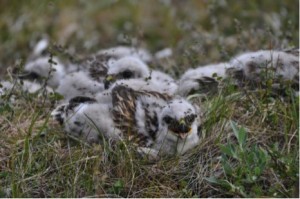
Nest with 6 chicks of rough-legged buzzards. Photo: M. Schaepman, 22 July, 2013.
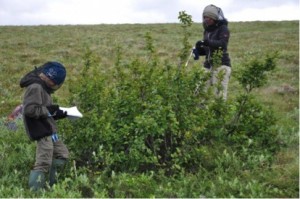
Measuring shrub position and extension, with the helping hand of a young secretary. Photo: M. Schaepman, 21 July 2013.
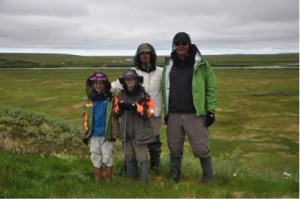
Taking vegetation relevees on the pingo south of the Berelech river, with Olga Khitun and the Schaepman family, who is testing ecotourism at Kytalyk station. The kids are impressed by the tundra life and seem to bother much less than adults about the mosquitos. Photo: O. Khitun, 21 July 2013.
Abgelegt unter: General
22. July 2013 |
Gabriela Schaepman-Strub |
Comments Off on Opening of the Kodak Station
by Gabriela Schaepman-Strub
Kytalyk, July 22, 2013
The area around Chokurdah is ideal to study the effects of climate change on vegetation and feedbacks, as over a relatively short distance at least five different vegetation zones are present that can be studied. So far we only concentrated on Kytalyk (southern hypoarctic tundra according to the Russian classification after B. Yurtsev et al., 1978), but we will evaluate an expansion during our boat trip soon. Last two days I got the chance to explore the more southern area of Chokurdah. Our Japanese colleagues, headed by Atsuko Sugimoto, invited me to the opening ceremony of their new tundra-taiga forest transition station. During the past few years, they were active at several experimental sites with isotope measurements for an improved understanding of the carbon and water fluxes. They now established a more permanent site with a 3m tower with instrumentation to assess the carbon, water, and energy balance.
The celebration started with a scientific presentation of the research by Trofim Maximov and Atsuko Sugimoto to the government of the region in the municipality building of Chokurdah. The presentations were followed by a few questions by locals: “Could the measuring towers be used to enhance the local mobile phone network?” “Is global warming really true (they had heard about the fact that not all scientists agree)?” “Can you help to assess the problem of the recent strong easterly winds that flooded Russkoe Ustje and destroyed the large permafrost cellar needed for storing the fish?”.
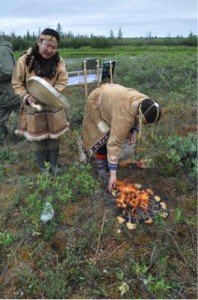
Two Eveni women in their role as shaman during the opening ceremony of Kodak station. While one is singing and playing the drum, the other is sacrificing food to the gods of nature. Photo: G. Schaepman-Strub, 16 July 2013.
In the afternoon, we had the unique opportunity to participate in an excursion to the new station. It was the combination of a scientific excursion, finally seeing some trees again, and an ethnological experience. It is a custom out here to invite a Shaman to connect to the gods of nature. The three Eveni women made a fire, they sang, danced and sacrificed food to the fire. They wanted to do the ceremony directly in front of the tower. This was followed by immediate protest by the scientists, who tried not to trample the vegetation around the tower when establishing it during the past few weeks. On top of that, the fire would be disturbing the CO2 concentration series quite a bit! The Shaman could not understand that a fire could not be lit at the most important spot and that people should walk on the wooden boardwalks only. Finally a compromise was found – the fire was lit behind the official sign of the celebration, a few hundred meters away from the tower, hopefully out of its measurement footprint.
At the end of the day a party followed at the local canteen, and the next morning an interview for Trofim Maximov at the local newspaper office to report about a recent visit of the journalist to Kytalyk station. He was visiting us by ponton when we unloaded the wood. During his walk around the station he was mostly fascinated by the warming experiment due to the large solar panels and the batteries. So more publicity for the research at Kytalyk station in the local news!
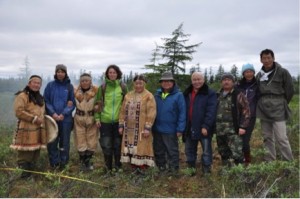
Group photo of the celebration for the opening of Kodak station.
Abgelegt unter: General⋅ Up and running
19. July 2013 |
Veruska Muccione |
Comments Off on A night of wood supply
by Gabriela Schaepman-Strub
Kytalyk, July 19, 2013
The story goes as follows: We had a very long walk yesterday to the pingo (Rus: була), about 4.5km away from our station, with many stops for vegetation relevees to complete our local flora. Wonderful weather, warm, the upcoming wind nicely kept the mosquitoes away. We found many new plant species and Olga is now almost happy with the diversity around Kytalyk. We had nice Lomo for lunch at the top of the pingo, making me and especially Maitane very happy!
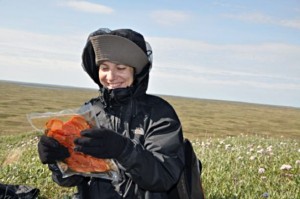
Maitane on top of the pingo, yesterday at lunch time. We enjoyed the lomo imported from Spain by Maitane. The pingo has an elevation of about 37m, allowing a beautiful view of the surrounding landscape, hundreds of km2 without people, breathtaking each time again (Photo: G. Schaepman-Strub, 12 July 2013).
We are sweating quite a bit, certainly on the way back. How much we will be enjoying the bania the same evening and refresh, wash the dirty clothes. As we arrive at the station, Bingxi is telling us that plans have changed – the pontoon will be coming tonight, just left Chokurdah at 2pm, no relaxing bania. Like last year, we will need to help with unloading the drift wood collected along the Indigirka that will serve on the station for cooking and heating (it provides heat at least 3 times – during unloading, sawing, chopping and carrying…). A big pile of wood, probably, as last year, and lots of work.
Further we are expecting a heavy diesel generator to start the closed-path methane analyzing system and some gas bottles for calibration of the instrumentation of the VU group. The pontoon is expected at around 7pm. But no boat at that time, and not until 11.30pm either. We are looking out of the window again and again. Last year we could see the pontoon from far away – as a white box moving through the tundra – as only the top of the ship is sticking above the shrub layer along the meandering river. After a short discussion with Lena we decide to go to bed. Knock, knock at our door at 2am – the pontoon is arriving – get up! Crawling out of the warm sleeping bag. A look out of the window. Terribly foggy. The arctic air brought cold weather during the 2.5 hrs we were sleeping. Putting on warmer clothes. Everybody up and waiting, suddenly we see the pontoon from a short distance, ok, let’s walk to the river bank. On our short way we see how the pont0on is coming closer, continuing, slowly, but steadily! What’s up? Did they miss the station due to the fog? Should we go back to sleep? The guy that came by small boat to help us unloading says that there is no problem, this was just the wrong pontoon. The one bringing the wood will arrive in about an hour. No reason to panic….
Lena is starting to clean the tschir that she brought for the Ukha (fish soup, Rus: Уха), we go back and have a cup of tea while waiting. What now? How crazy life is out here sometimes! I start writing. Olga takes her field book and is updating me on the status of the species count in the middle of the night– there were 42 species on Roman’s list, we are at 90 now!
Some people go back to bed. No sound of the large pontoon engine and of course nothing to see through the fog … Ok, then back to bed…. Difficult to fall asleep, the wind is blowing and each time the chimney is shaking we fear that it is the noise of Lena coming up the stairs and waking us up to help, not the only nightmare tonight…. Eventually the pontoon arrives at 6am, we get up and help the local guys to unload the huge pile of wood, they manage the diesel generator and the barrels with fuel and diesel (not even thinking about how heavy all this is – they are carrying the generator to the tundra with the four of them – judging the weight by the heavy stems they carried before, the generator must be REALLY heavy!).
After realizing how long they have been up and working during the night we cannot complain at all anymore that we had to get up for nothing at 2am (their start in Chokurdakh was delayed to 6pm yesterday as they had to wait for some cargo from the plane that arrived on Friday afternoon, collected all the drift wood on the way and arrived this morning at the station)! At 7am an Ukha for them and a rice porridge for us, a few toasts on the good collaboration of locals and scientists, a short discussion with a journalist of the local newspaper who came out to take some pictures (Trofim Maximov from IBPC will provide the text) and off they are on the pontoon to Chokurdakh. Looking out of the window to the foggy river- the pontoon makes some strange noise, redraws, the guys are cleaning the platform.
To Lena who stayed up all night cooking for 17 people, and to the whole crew who came out – сбасиба (thanks a lot!)!!
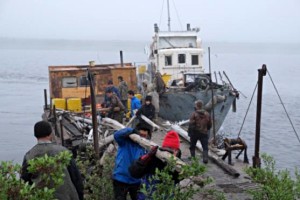
Pontoon with about a quarter of the wood left. Luckily we were many people to help at 6am this morning, but everybody was very tired after a sleepless night … (Photo: I. Juszak, 13 July 2013).
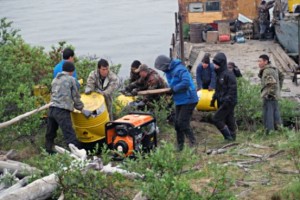
Unloading the barrels and the diesel generator. We could never have done so by our own! (Photo: I. Juszak, 13 July 2013).
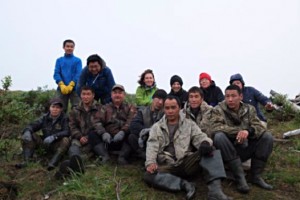
The whole group that helped unloading the boat, while the people from Chokurdakh first collected the drift wood along the river on their way to the station during the night (Photo: I. Juszak, 13 July 2013).
Abgelegt unter: Up and running
17. July 2013 |
Veruska Muccione |
Comments Off on The beauty of Siberia
by Binxi Li
Kytalyk, July 17, 2013
Hi everyone :-)! This is Bingxi Li from Wageningen University, the Netherlands this time. Today I volunteered to write a new blog and this time I will try to show you the beauty of eastern Siberian tundra through my eyes.
This is my third summer season in Kytalyk nature reserve, northeastern Siberia. The views and landscapes around our base have become so familiar to me. From the ground, the view is usually far from fascinating, compared with the satellite image of this area. It is a vast flat area with only short growing vegetation, while the only high points in our sight are a few pingos, one of which around 4 kilometers away is the background of most our pictures. In spite of this “boring” landscape, I am still largely obsessed by Siberia. The unpredictable arctic weather not only makes troubles to our daily life and research activities, but also switches the colors of the land, especially at midnight. The midnight sunshine here is gorgeous in summer. The low sun angle creates extremely long shadows so that the contrast ratio is high. The red or orange sunshine softly covers everything of this land and coloring everything. When the clouds partly cover the sun, countless rays of light penetrate through the gaps, shining out with great brilliancy. The various cloud shapes in the crystal blue sky add extra beauty to this landscape. Everybody in Kytalyk is so addicted to the midnight view. According to my unreliable guess, people need significantly more time to go to the toilet at night than during the day, simply because we always waste some additional minutes on appreciating the beautiful view. Thus, going to the toilet with camera is a new fashion in Kytalyk. Personally, I cannot remember how many gigabytes I spent in storing the picture of the night sunshine with the background of the pingo, but still I could not stop myself taking pictures from almost the same angle now and then. It is simply so … beautiful!
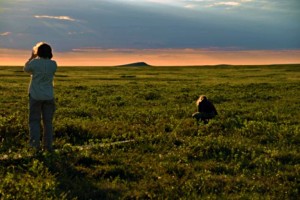
Midnight photo session in Ktalyk (Photo: B. Li, July 2013).
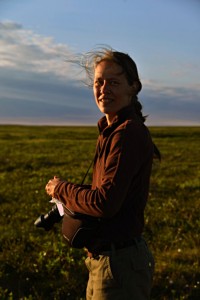
Inge in the twilight (Photo: B. Li, July 2013).
The wild life here is also amazing. The summer is the liveliest time in Siberia. Many birds fly thousands of miles from China, Southeast Asia and even Australia to the very north, their summer destination. Creating and feeding new generations is the reason of the great migrations. Several couples of tundra swans have their nest near our base, they probably just come from Huanghe delta near the Yellow Sea and the blue throat thrush, a beautiful large robin-like species with marvelous songs, always flies around our kitchen, might just have finished their warm winter holiday in Hongkong one month ago. Rough legged buzzard couples are from Mongolia or Southern Far East Russia. Sandhill cranes, the relatives of the Kytalyk star species Siberian white crane, come from the US and Canada. Sometimes, I have the illusion that I am just one of millions of them, only for a different purpose. When I see these birds, I often imagine that maybe we have seen each other long before in my lovely hometown far in the south and accidentally meet each other again here, like two old friends.
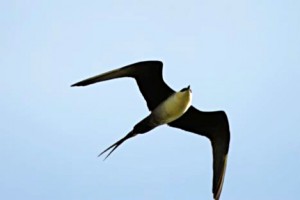
Life is amazing, isn’t it? (Photo: B. Li, July 2013).
Abgelegt unter: General
16. July 2013 |
Veruska Muccione |
Comments Off on List of species and prices
by Gabriela Schaepman-Strub
Kytalyk, July 16, 2013
Time is running too fast and in one week we will be travelling up north to explore a hillside area and Russkoe Ustje, a village close to the Indigirka delta. Tomorrow I will be picked up to participate in a ceremony for the opening of the Tundra-taiga Forest Station. It will be a good opportunity to see this new research site established by our Japanese colleagues.
Measurements are going well, we now get regular energy balance component measurements of our two vegetation sites. Olga is great in helping us with species determination in our small diversity plots and with Braun-Blanquet relevees to assess the species associations of Kytalyk. We plan to compile a list of species of the area in English and Russian, including photos. This will be of interest to our international colleagues as well as to Tatjana who is responsible for the nature reserve. It is not easy to get such an experienced botanist to this site, and we are very grateful to Olga Khitun that she agreed to help us.
Given that we travel to such a remote site, involving rather high costs, we try to respond to sampling requests from the international science community, such as for pan-arctic investigations. This year we try to collect a few Cardamine species (no success yet, we only found Cardamine pratensis so far), mono- and dicots of the area for age and productivity determination from annual rings, as well as Salix polaris for genetic analysis. Olga knew that Salix polaris is not a very common species for this vegetation zone, but she found yesterday a first patch in the one and only snowbed and I discovered a second patch today in the same snowbed. This means we can provide 2 samples – instead of 30 as requested by the study, but maybe we will find more when travelling further north. It is good to have Olga here. She was growing up in Soviet Union times and has great stories from her many years with expeditions to Yamal. Lately I was wondering about the engraved numbers in the aluminium pot on the table.
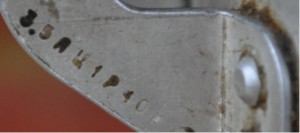
Aluminium pot of 3.5 litres, price (ц for цена) 1 Rubel 40 Kopek. Photo: G.Schaepman-Strub, 14 July 2013.
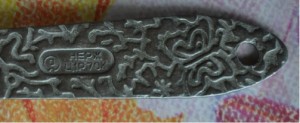
Ladel for serving soup. Price 1 Rubel 70 Kopek. Photo: G.Schaepman-Strub, 14 July 2013.
Olga tells us that since the financial reform in 1961, prices for goods stayed the same until the Soviet Union broke apart. No changes in price meant that they could engrave the price onto pots, spoons, forks (and yes, most often people ate without knifes). We still have to learn a lot about old times in Russia! We found a new sport – who finds the next price? I think I will bring out some new spoons and forks next time in exchange for a real Soviet Union set with imprinted prices, mmhhh…. but then maybe some of the atmosphere will be gone in Kytalyk…. By the way – Olga, like most of the people older than 20 years, still remembers many prices for food (even though you could not get some food such as meat most often…):
| Bred (хлеб) | 14 Kopek per kilo |
| Meat | 2 Rub per kilo |
| Butter | 3 Rub 60 Kopek per kilo |
| Vodka | 3 Rub 62 Kopek |
| Cheese | approx. 3 Rub per kilo (depending on the type of cheese) |
| Sausage | 2 Rub 20 Kopek |
| Black caviar | 4 Rub for 400g (impossible to buy) |
| Can of instant coffee | 6 Rub (very expensive as well) |
1 Dollar was 60 Kopek at that time, but people were not allowed to exchange. This remained the same price throughout the whole Soviet Union. Well, not today anymore! A kg of potato costs around 20 Rub in St. Petersburg, but 200 Rub (approx. 5 EUR) in Chokurdah!
Abgelegt unter: General
15. July 2013 |
Veruska Muccione |
Comments Off on First data – looking good!
by Gabriela Schaepman-Strub
Kytalyk, July 15, 2013
Yesterday we downloaded the first few days of data from the two energy flux towers on wet sedge and dry dwarf birch patches. The data looks reasonably good so far. We did catch a very sunny day resulting in a beautiful irradiance curve. The towers include an albedometer, net short- and longwave radiation sensors, air temperature thermistors, a nadir- and an oblique looking time-lapse camera used for assessing the phenology and snow melt patterns next year, as well as PAR sensors placed below the leaves to measure radiation transmitted through the canopy. Additionally we started with structural measurements – point quadrant measurements to estimate leaf area, active layer thickness (ALT) that is currently around 15cm for Betula nana patches, but already around 20cm for wet sedge areas. We are really looking forward to see how the fluxes of the two patches develop throughout the season and under varying atmospheric conditions.
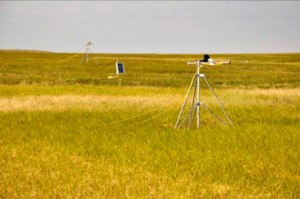
The two energy flux towers, in the front the wet sedge patch with deep active layer, in the back the slightly elevated dwarf birch patch, both with the corresponding flux tower (Photo: G. Schaepman-Strub, 9 July 2013).
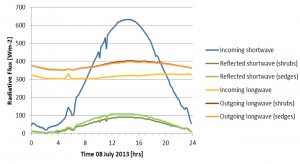
First energy flux measurements on an almost perfectly sunny day (08 July 2013). Plot includes incoming short- and longwave radiation, as well as reflected shortwave and outgoing longwave for shrub-dominated and sedge-dominated patches (Data: I. Juszak, G. Schaepman-Strub, UZH, 2013).
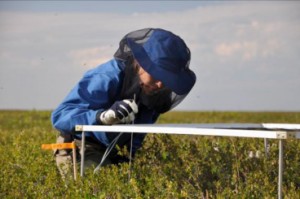
Inge Juszak busy with one of the 81 point quadrant measuring points. We note down every leaf and branch, as well as mosses or background type that the thin lowered needle is hitting at each point. Not an easy job to lean over the 1x1m grid and look through the canopy with a mosquito head-net on and hundreds of our dear friends flying around us (Photo: G. Schaepman-Strub, 9 July 2013).
PS: On the way to the plot I found a first edible mushroom of the season between dwarf birches – unfortunately will not provide a big meal ;-). It is quite tiny as compared to his relatives growing in Europe! More on collecting berries and mushrooms will probably follow when I am off already to Russkoye Ustye, a small village further up North. I remember that in 2010 walking through the tundra was very slow as we constantly stopped to pick some salmon-colored beautiful and tasty cloudberries to increase our vitamin C level …!

First edible mushroom of the season discovered on the way to the tower measurement site (Photo: G. Schaepman-Strub, 9 July 2013).
Abgelegt unter: Up and running
13. July 2013 |
Veruska Muccione |
Comments Off on Social life in the tundra
by Gabriela Schaepman-Strub
Kytalyk, July 11, 2013
In addition to the scientific research we are running a social experiment out here – we are only missing a control group 😉
There are PhD students experiencing the site conditions for the first time. The PhDs who do research out here usually arrive as very independent personalities – otherwise they quickly adapt. Others are out for the last summer of their PhD, collecting data that will go into the analysis of the manuscript waiting at home for this last data point, almost ready to be submitted. They are very experienced about how daily life is organized and how to deal with delays in field schedules or boats arriving later than expected. Most of them quite sad that this long-term experience comes to an end. PhDs stay for 6-7 weeks every summer, considered to be the maximum we ask students to live in the tundra, far away from friends and family, with simple food, bright nights, no shower, no washing machine, away from daily news. The supervisors join in the beginning of the field work for 2-3 weeks. Helping to set up experiments, taking decisions about selection of sites and measurements, help out with infrastructure issues.
Be it PhDs or supervisors, in the end, everybody needs to share rooms (now and then kept awake by others snoring through the thin wooden walls), share the bania, sit together during meals. Funny to see who is taking up responsibilities for which tasks, such as filling fresh water into the hand washing bucket or emptying the used one, taking care of the bania fire, charging of devices, ordering food and fuel, just all the little things that have to happen. At some point all this feels like at home, maybe with similar roles, but not sure about this….. We do not have any fixed duties, but somehow tasks get distributed over time and people. Luckily the cook is asking the guys to pump water or cut wood – not a womens job in Russia. Well, we have to carry the wood which is not much easier. Obviously also other social domains are interesting to observe.
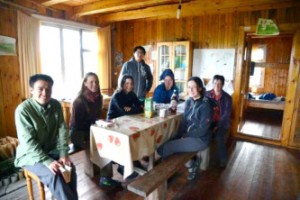
Scientists currently in Kytalyk, joining for a beer on Saturday evening after the bania (from left to right): Pen Wang (Wageningen University), Inge Juszak (UZH), Maitane Iturrate (UZH), Bingxi Li (WU), Angela Gallagher (VU Amsterdam), Gabriela Schaepman-Strub (UZH), Monique Heijmans (WU) (Photo: Bingxi Li, July 2013).
When people arrive to the site they are usually very talkative, bring in news from Yakutsk or Europe, then gradually get more silent with the duration of their stay. At some point the discussions at table are mostly about food, weather forecast, charging devices, teasing each other about customs that have established out here such as eating mayonnaise in the soup, mayonnaise in the porridge, mayonnaise on the bread topped by jam… until somebody new comes in. But usually we get in fresh ideas every 7-10 days, with new persons arriving.
Most often social life out here is really good and people help out each other a lot – would simply not be possible otherwise, we all need support at some point, be it by a helping hand, to replace a missing screw or repair a broken device. And if people have a difficult day there is enough time to be alone during measurements, get fresh air, take a walk, listen to music or read a few pages in a digital book which is very easy to bring nowadays. I would like to thank everybody being around this year and supporting each other in Kytalyk – it’s great to know that you’re not alone! And if everything fails in the field we still have the connection to ‘outer space’ – the phone line to Yakutsk.
Sadly we just got the news from Olga arriving from Yakutsk that Stas has been involved in a car accident and needed to go to the hospital. We wish him all the best for a fast and sustainable recovery!
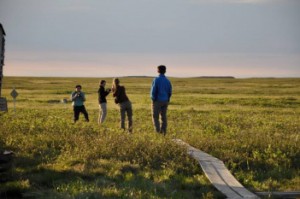
Photo shooting session at midnight. Who takes the nicest picture of the pingo 5km away? (Photo: G. Schaepman-Strub, 7 July 2013).
Abgelegt unter: General
11. July 2013 |
Michael Schaepman |
Comments Off on Colordiversity (NASA/USGS Landsat 8 to map Kytalyk on July 5)
by our staff writers
July 11, 2013
In it’s regular acquisition scheme, Landsat 8 maps the same location on Earth every 16 days. On July 5, 2013, Landsat 8 observed the Kytalyk area under an almost cloud-free scenario*.
NASA’s Landsat program is a series of Earth observing satellites operating since 1972 almost continuously! The first Landsat 8 scene was released on March 21, 2013 – just a few month’s ago! Landsat 8 carries two push-broom instruments: the Operational Land Imager (OLI), and the Thermal Infrared Sensor (TIRS). Here we show you some images from the OLI instrument.
OLI has 9 spectral bands (‘it can see (record) nine different colors at the time’). Eight of the spectral bands are recorded at 30 m spatial resolution, while one spectral band (band 8 in fact) is recorded at 15 m spatial resolution.
Since our eyes are limited to trichromacy, we can use any permutation of the eight (nine) Landsat bands to create colorful and meaningful images with three of the bands at the time. Each of the spectral bands in Landsat 8 have been designed to serve a distinct purpose. You can see below a nice graph showing atmospheric transmission and the location of the OLI and TIRS bands in the electromagnetic spectrum. Also you can see a comparison with the previous, Landsat ETM+ instrument’s spectral bands setting.
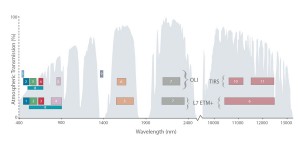
Atmospheric transmission and Landsat 7/8 band positions in the solar reflected / emitted wavelength range (Data: landsat.usgs.gov).
In the following figure, we have put together three different band combinations of Landsat 8. Left is a ‘natural color’ image, in which Landsat 8 band 4 is assigned to the color ‘red’ on your screen, Landsat 8 band 3 to ‘green’ and Landsat 8 band 2 to ‘blue’. This resulting in a RGB image. The middle image is called a ‘color infrared’ image (with the capability to display green vegetation in red). The corresponding band combination is 5->R, 4->G, 3->B. Finally, right is a false color image using the band combination 6->R, 5->G, 4->B.
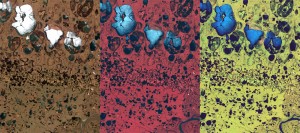
Three band combinations of Landsat 8 data of the Kytalyk area on July 5, 2013 (Data courtesy: NASA/USGS, earthexplorer.usgs.gov).
Band 8 of Landsat 8 is a so-called panchromatic band. This band is sensible to all visible wavelengths and is recorded with doubling the spatial resolution as compared to the other OLI bands. A band 8 image is therefore always in shades of grey, but records 4 pixels instead of one of the other bands.
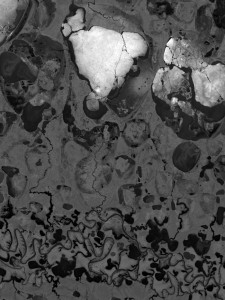
Panchromatic image (not at full resolution and jpeg compressed) of the Kytalyk area on July 5, 2013 (Data courtesy: NASA/USGS, earthexplorer.usgs.gov).
Should you have a good internet connection to this blog, you can download the following images in full resolution (still as jpeg’s with some compression noise). If you wish to see the whole scene (180 x 180 km) in original resolution (geoTIFF, no compression) – apologies for the techno-babble – look for LANDSAT_SCENE_ID = “LC81170102013186LGN00”, WRS_PATH = 117, WRS_ROW = 10 in a Landsat archive such as http://earthexplorer.usgs.gov/.
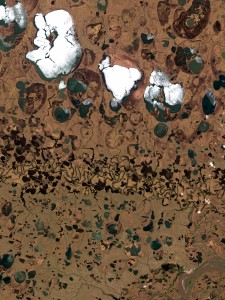
True color composite based on a subset of a Landsat 8 scene recorded on July 5, 2013 (Data:USGS).
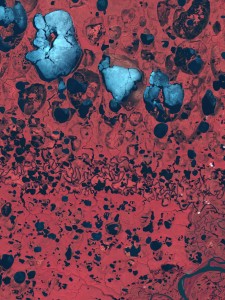
Color infrared composite based on a subset of a Landsat 8 scene recorded on July 5, 2013 (Data:USGS).
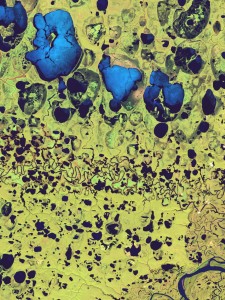
False color composite based on a subset of a Landsat 8 scene recorded on July 5, 2013 (Data:USGS).
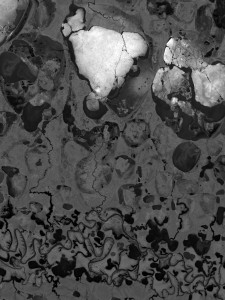
Panchromatic image based on a subset of a Landsat 8 scene recorded on July 5, 2013 (Data:USGS).
* Landsat 8 acquisition of all URPP GCB test sites is made possible with the support of ESA ESRIN’s Bianca Hoersch. Her support is greatly acknowledged!
Abgelegt unter: General
9. July 2013 |
Maitane Iturrate Garcia |
Comments Off on Speices mapping unraveled
by Maitane Iturrate
Kytalyk, July 9, 2013
Back to work again, since yesterday we took the day off. Our first “free” day, although the concept of free was a bit weird: chop wood, carry wood, pump water, manage waste disposal, clean, tidy up… Luckily, past 16:30h it became a really free day, even dinner was special with reindeer meat balls with pasta and special bread. And at end of the day, we even watched a film!
The first week of field work passed by really fast. After selecting my 30 plots, I started to determine the species composition of my plots. The process was straightforward: placing a grid of 50 by 50 centimeters divided in 25 smaller quadrants and identifying the different species, while noting down presence and absence. While on the first day I only could see the little quadrants full of vegetation. However, after two days, each quadrant became like a little mini-forest with several strata, where I could see how the mosses tried to escape from the shade of Betula nana growing higher up, or how the composition of species changes when Peltigera aphtosa was occupying most of the ground. Awesome!
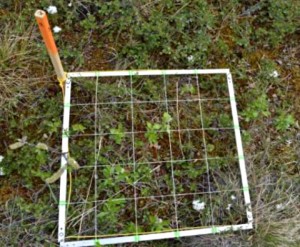
Grid used for determining species composition (Photo: M. Iturrate, July 2013).
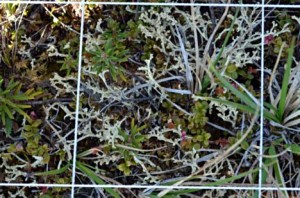
Quadrant of the grid used for determining species composition (Photo: M. Iturrate, July 2013).
Some species were really easy to identify, such as the Cassiope tetragona, Arctostaphylos alpina or Betula nana, but for others I had many problems, so at the moment I only have the description of them. The good point is that today Dr. Olga Khitun, a Russian botanist, has arrived. She will teach me how to identify species unknown to me and how to sample relevés using the Braun-Blanquet approach to determine species associations around Kytalyk.
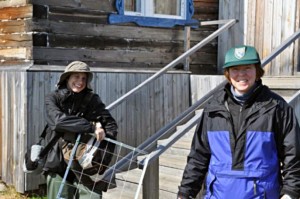
Maitane Iturrate and Olga Khitun ready to assess the floristic diversity in the Kytalyk area. Up to now our list contains about 60 different species – let’s see how many more we will find! We welcome any bets on this … (Photo: G. Schaepman-Strub, July 2013).
I’m looking forward to starting to work together with her although it will be very intense again. We were walking around the research site after her arrival in order to get a first impression of the vegetation composition. It is great to see her stopping every few steps to explain me which species are there or her taking species samples if she is not sure about them herself. I feel really privileged of getting her help and learn from her knowledge and experience she gained in other arctic places such as Yamal.
Abgelegt unter: Up and running
































